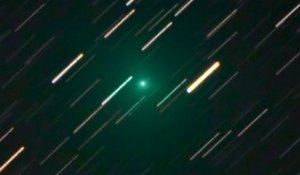Previous returns of Comet Tuttle to the inner solar system have been attended by outbursts of meteors, most recently in 1980 and 1994. During those flurries, dozens of meteors per hour streamed from the constellation Ursa Minor--hence the name of the shower, "the Ursids."

|
| ©Chris Schur |
| Comet 8P/Tuttle photographed Dec. 2nd by Chris Schur of Payson, AZ. The 7th magnitude comet is visible through binoculars in the constellation Cassiopeia. |
Although Ursids have a reputation for being faint, "we are not certain about this," says Jenniskens. "Because winter weather keeps many observers indoors, Ursid outbursts have never been widely observed and they may contain a fair number of bright meteors. We have a lot to learn." That's why he hopes sky watchers will keep an eye on the northern sky this weekend; Ursid meteors emerge not far from the north star, Polaris.
According to models by Jenniskens and colleagues, the peak will occur between 2100 and 2200 UT (4-5 pm EST) on Dec. 22nd with meteors visible as much as four hours before and after that time. Anything could happen, from a dud to a blast. Bundle up and look!



Reader Comments
to our Newsletter